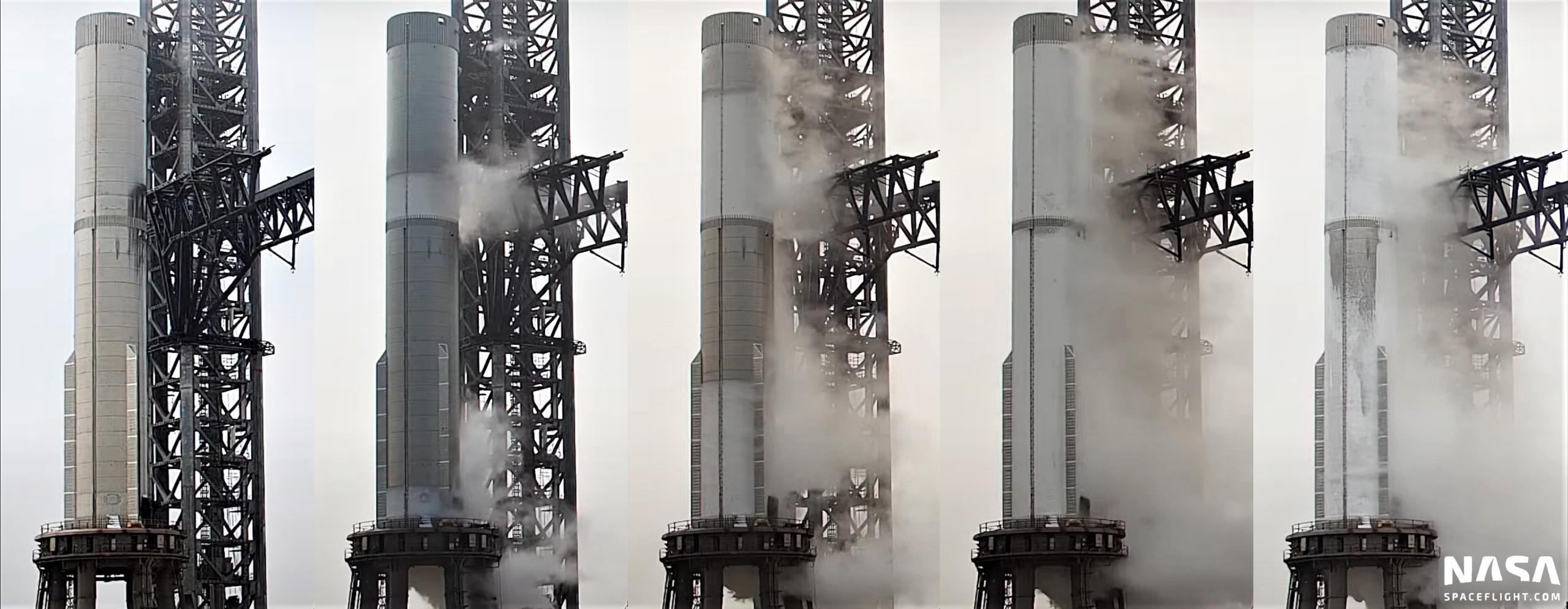
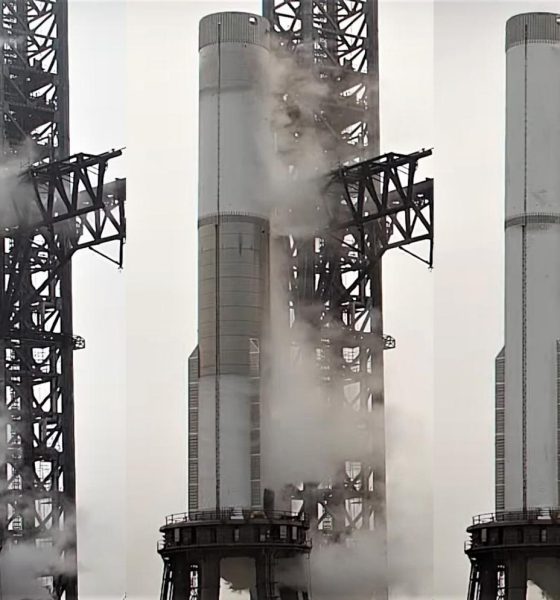
News
SpaceX’s upgraded Super Heavy booster sails through first major test
SpaceX’s first upgraded 33-engine Super Heavy booster appears to have passed a crucial test with surprising ease, boding well for a smooth qualification process.
Attempting that test so early on did not appear to be SpaceX’s initial plan. Instead, shortly before Super Heavy Booster 4’s third and likely final removal from Starbase’s ‘orbital launch mount’ (OLM) on March 24th, SpaceX transported a massive structural test stand from a Starbase storage yard to the orbital launch site (OLS), where technicians have focused on modifying nearby ground systems to support apparent structural testing of Super Heavy Booster 7. As of March 31st, all available evidence suggested that SpaceX was preparing that stand to verify Booster 7’s mechanical strength and simulate the major stresses it might experience before investing a significant amount of time and resources in qualification testing.
However, SpaceX appeared to change its plans at the last minute.
Instead of starting with structural testing, after a brief two-day pause, SpaceX rolled Super Heavy B7 into place and craned the giant booster onto the orbital launch mount on April 2nd. On April 3rd, the launch mount’s “quick disconnect” device connected Super Heavy to the pad’s ground systems. On April 4th, just two days after its installation on the OLM, Super Heavy B7 kicked off the first in a series of qualification tests that will determine when or if the booster ultimately supports Starship’s first orbital launch attempt.
If testing goes perfectly, SpaceX CEO Elon Musk recently stated that Starship and Super Heavy – likely Ship 24 and Booster 7 – could be ready for an inaugural orbital launch attempt as early as May 2022. SpaceX appears to have leaped headfirst into Super Heavy Booster 7 qualification testing in a move that significantly increases the likelihood of meeting that extremely ambitious schedule. Normally, with a first-of-its-kind prototype debuting multiple significant design changes, SpaceX would start slow, possibly beginning with a basic pneumatic proof test to verify structural integrity at flight pressures – about 6.5-8.5 bar (95-125 psi) – with benign nitrogen gas before calling it a day.
With Booster 7, SpaceX likely still performed a quick pneumatic proof but then immediately proceeded into a full-scale cryogenic proof test. With Super Heavy B4, for example, SpaceX performed several increasingly ambitious cryogenic proof tests, filling the booster more and more each attempt but never actually topping it off. On Booster 7’s very first day of testing and first cryogenic proof attempt, SpaceX fully loaded the upgraded Super Heavy with a cryogenic fluid (likely liquid nitrogen) in just two hours – all with no significant unplanned holds (pauses).
In those two hours, SpaceX likely loaded Super Heavy B7’s liquid methane (LCH4) and oxygen (LOx) tanks with roughly 3400 metric tons (~7.5M lb) of liquid nitrogen (LN2) – not far off what Super Heavy would actually weigh at liftoff. At the peak of the test, Booster 7 was almost entirely covered in a thin layer of ice produced as the cryogenic liquid inside its tanks froze water vapor in the humid South Texas air onto its skin – an effect that effectively turns uninsulated cryogenic rockets into giant fill gauges. On top of running into no apparent issues, Super Heavy B7’s first cryogenic proof is also the first time any Super Heavy prototype has been fully filled during testing – an important milestone for any rocket prototype, let alone the largest rocket booster ever built.
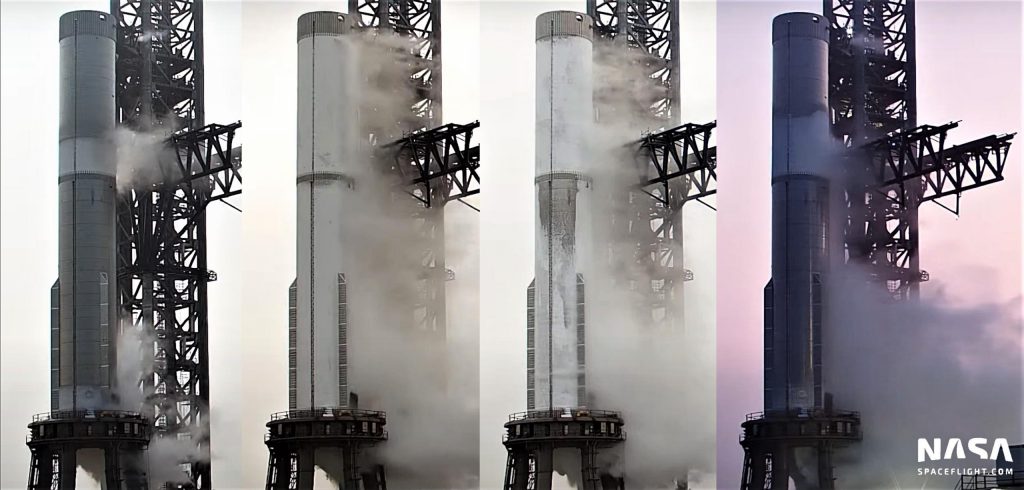
Completing a full cryogenic proof test on its first try makes Booster 7 fairly unique among all Starship prototypes – not just Super Heavies. The contrast with Booster 4, which barely completed a handful of partial cryogenic proof tests in more than half a year spent at Starbase’s orbital launch site, is also extremely encouraging, suggesting that Booster 7 won’t be sitting inactive for months at a time.
Still, cryogenic proofing is just one of several important tests Booster 7 needs to complete. Even if the first test was nearly perfect and SpaceX doesn’t attempt one or several more cryoproofs with higher tank pressures or other tweaked variables, Super Heavy B7 needs to complete wet dress rehearsal testing (WDR) with flammable LCH4/LOx propellant and demonstrate autogenous pressurization (using heated propellant gas to pressure its tanks). At some point, SpaceX will also need to install a full 33 Raptor V2 engines on the booster and seal off the whole engine section and each Raptor with a heat shield.
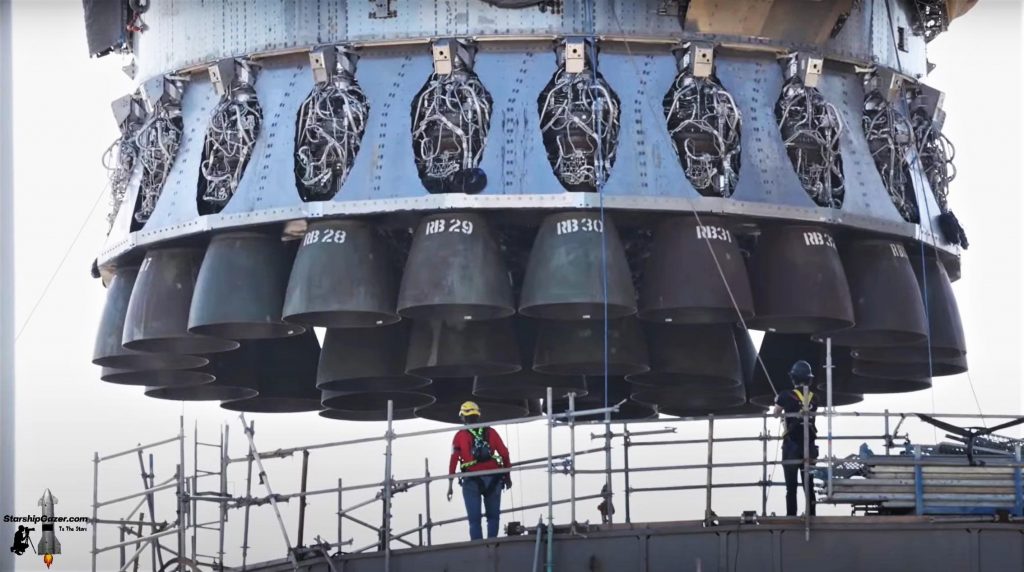
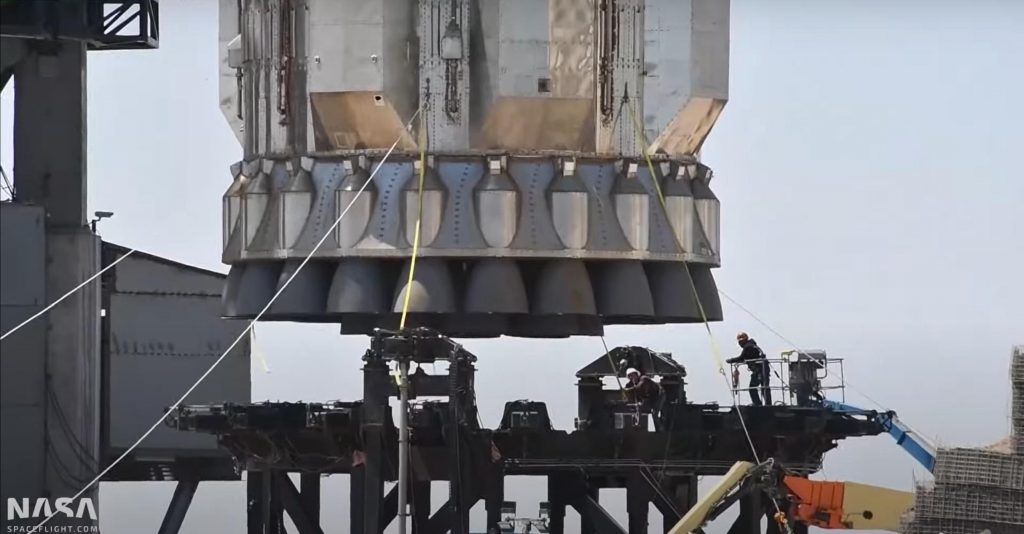
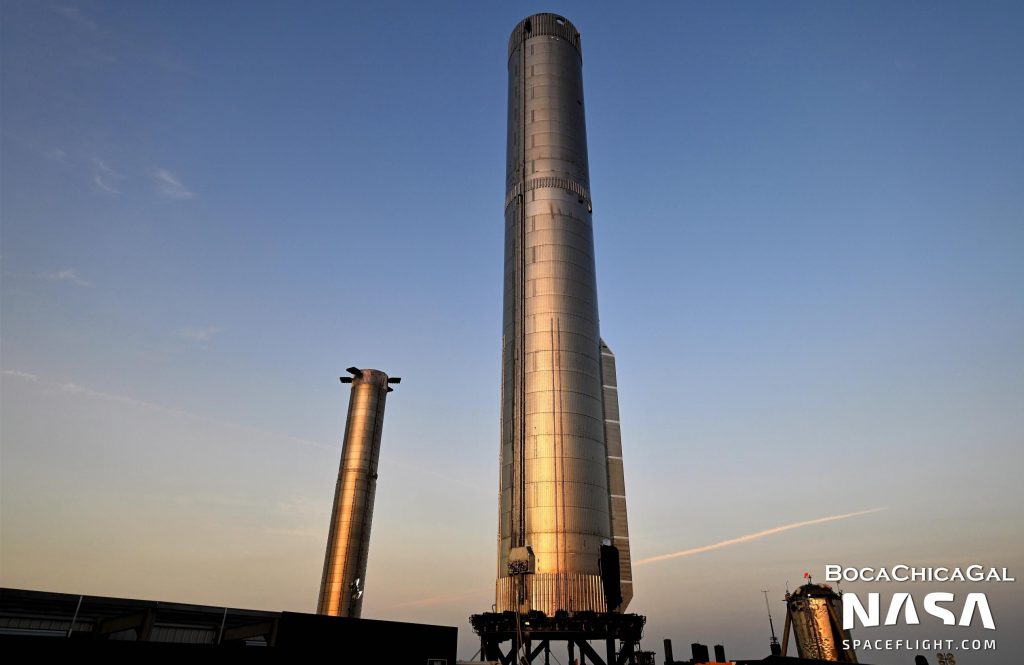
Depending on how many Raptor V2 engines are available, SpaceX could begin static fire testing with just a few engines installed and shielded and then install the rest of the engines and heat shield later on. On the other hand, performing static fires without a full heat shield could risk damaging unprotected cabling or other subsystems, in which case wet dress rehearsal testing would likely follow immediately after cryoproofing and before engine or shield installation. After being skipped over, the structural test stand may also factor into Booster 7 qualification sometime before engine installation.
All told, plenty of uncertainty remains, but Super Heavy B7’s auspicious start suggests that the Booster 4 experience is far from a template and that SpaceX is much less interested in wasting time this time around.

News
Elon Musk’s Grokipedia surges to 5.6M articles, almost 79% of English Wikipedia
The explosive growth marks a major milestone for the AI-powered online encyclopedia, which was launched by Elon Musk’s xAI just months ago.

Elon Musk’s Grokipedia has grown to an impressive 5,615,201 articles as of today, closing in on 79% of the English Wikipedia’s current total of 7,119,376 articles.
The explosive growth marks a major milestone for the AI-powered online encyclopedia, which was launched by Elon Musk’s xAI just months ago. Needless to say, it would only be a matter of time before Grokipedia exceeds English Wikipedia in sheer volume.
Grokipedia’s rapid growth
xAI’s vision for Grokipedia emphasizes neutrality, while Grok’s reasoning capabilities allow for fast drafting and fact-checking. When Elon Musk announced the initiative in late September 2025, he noted that Grokipedia would be an improvement to Wikipedia because it would be designed to avoid bias.
At the time, Musk noted that Grokipedia “is a necessary step towards the xAI goal of understanding the Universe.”
Grokipedia was launched in late October, and while xAI was careful to list it only as Version 0.1 at the time, the online encyclopedia immediately earned praise. Wikipedia co-founder Larry Sanger highlighted the project’s innovative approach, noting how it leverages AI to fill knowledge gaps and enable rapid updates. Netizens also observed how Grokipedia tends to present articles in a more objective manner compared to Wikipedia, which is edited by humans.
Elon Musk’s ambitious plans
With 5,615,201 total articles, Grokipedia has now grown to almost 79% of English Wikipedia’s article base. This is incredibly quick, though Grokipedia remains text-only for now. xAI, for its part, has now updated the online encyclopedia’s iteration to v0.2.
Elon Musk has shared bold ideas for Grokipedia, including sending a record of the entire knowledge base to space as part of xAI’s mission to preserve and expand human understanding. At some point, Musk stated that Grokipedia will be renamed to Encyclopedia Galactica, and it will be sent to the cosmos.
“When Grokipedia is good enough (long way to go), we will change the name to Encyclopedia Galactica. It will be an open source distillation of all knowledge, including audio, images and video. Join xAI to help build the sci-fi version of the Library of Alexandria!” Musk wrote, adding in a later post that “Copies will be etched in stone and sent to the Moon, Mars and beyond. This time, it will not be lost.”
News
Tesla Model 3 becomes Netherlands’ best-selling used EV in 2025
More than one in ten second-hand electric cars sold in the country last year was a Tesla Model 3.

The Tesla Model 3 became the most popular used electric car in the Netherlands in 2025, cementing its dominance well beyond the country’s new-car market.
After years at the top of Dutch EV sales charts, the Model 3 now leads the country’s second-hand EV market by a wide margin, as record used-car purchases pushed electric vehicles further into the mainstream.
Model 3 takes a commanding lead
The Netherlands recorded more than 2.1 million used car sales last year, the highest level on record. Of those, roughly 4.8%, or about 102,000 vehicles, were electric. Within that growing segment, the Tesla Model 3 stood far ahead of its competitors.
In 2025 alone, 11,338 used Model 3s changed hands, giving the car an 11.1% share of the country’s entire used EV market. That means more than one in ten second-hand electric cars sold in the country last year was a Tesla Model 3, Auto Week Netherlands reported. The scale of its lead is striking: the gap between the Model 3 and the second-place finisher, the Volkswagen ID3, is more than 6,700 vehicles.
Rivals trail as residual values shape rankings
The Volkswagen ID.3 ranked a distant second, with 4,595 used units sold and a 4.5% market share. Close behind was the Audi e-tron, which placed third with 4,236 registrations. As noted by Auto Week Netherlands, relatively low residual values likely boosted the e-tron’s appeal in the used market, despite its higher original price.
Other strong performers included the Kia Niro, the Tesla Model Y, and the Hyundai Kona, highlighting continued demand for compact and midsize electric vehicles with proven range and reliability. No other model, however, came close to matching the Model 3’s scale or market presence.
News
Tesla Model Y Standard Long Range RWD launches in Europe
The update was announced by Tesla Europe & Middle East in a post on its official social media account on X.

Tesla has expanded the Model Y lineup in Europe with the introduction of the Standard Long Range RWD variant, which offers an impressive 657 km of WLTP range.
The update was announced by Tesla Europe & Middle East in a post on its official social media account on X.
Model Y Standard Long Range RWD Details
Tesla Europe & Middle East highlighted some of the Model Y Standard Long Range RWD’s most notable specs, from its 657 km of WLTP range to its 2,118 liters of cargo volume. More importantly, Tesla also noted that the newly released variant only consumes 12.7 kWh per 100 km, making it the most efficient Model Y to date.
The Model Y Standard provides a lower entry point for consumers who wish to enter the Tesla ecosystem at the lowest possible price. While the Model 3 Standard is still more affordable, some consumers might prefer the Model Y Standard due to its larger size and crossover form factor. The fact that the Model Y Standard is equipped with Tesla’s AI4 computer also makes it ready for FSD’s eventual rollout to the region.
Top Gear’s Model Y Standard review
Top Gear‘s recent review of the Tesla Model Y Standard highlighted some of the vehicle’s most notable features, such as its impressive real-world range, stellar infotainment system, and spacious interior. As per the publication, the Model Y Standard still retains a lot of what makes Tesla’s vehicles well-rounded, even if it’s been equipped with a simplified interior.
Top Gear compared the Model Y Standard to its rivals in the same segment. “The introduction of the Standard trim brings the Model Y in line with the entry price of most of its closest competition. In fact, it’s actually cheaper than a Peugeot e-3008 and costs £5k less than an entry-level Audi Q4 e-tron. It also makes the Ford Mustang Mach-E look a little short with its higher entry price and worse range,” the publication wrote.








